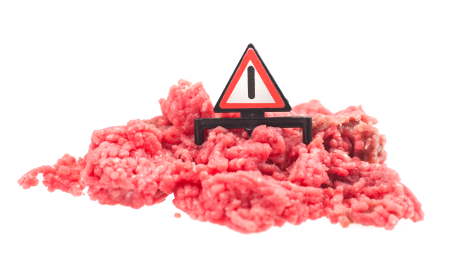 If Cargill’s 36 million pounds of antibiotic-resistant-salmonella-tainted turkey that sickened 77 people and killed one (at last count) proves anything, it’s this: The government’s approach to regulating disease-causing pathogens like salmonella and E. coli in food the same way it regulates plaster, chalk, or even melamine simply doesn’t work.
If Cargill’s 36 million pounds of antibiotic-resistant-salmonella-tainted turkey that sickened 77 people and killed one (at last count) proves anything, it’s this: The government’s approach to regulating disease-causing pathogens like salmonella and E. coli in food the same way it regulates plaster, chalk, or even melamine simply doesn’t work.
According to the USDA and FDA, stuff added to food that makes it dangerous to eat is an “adulterant.” And adulterants in food are illegal. So far, so good. But it turns out that at USDA, it’s not enough that meat has something in it that shouldn’t be there. It has to be something that the agency officially considers an adulterant. And that fact has provided a regulatory loophole that Cargill was able to drive 36 million pounds of contaminated turkey through.
How so? Maryn McKenna explains over at Wired Science that the USDA neglected/refused to declare the particular strain of salmonella that contaminated Cargill’s turkey an adulterant. Therefore, Cargill wasn’t breaking any law in distributing turkey containing this superbug. And to the extent the government knew about problems at the Cargill facility that produced all the turkey (which it appears they did as early as May), there was little they could do.
And even knowing the full extent of the contamination as they do now, the government can’t really punish Cargill because, according to our food safety regime, Cargill didn’t do anything illegal. The system, after all, is designed to stop adulterants — and the USDA in particular only acts proactively against disease-causing pathogens to the extent they are classed as adulterants. McKenna highlights the impact of such a declaration:
Declaring an organism an adulterant doesn’t only make it illegal for food producers to distribute. It also imposes a duty on federal food-safety agencies to detect its presence in food so as to prevent its distribution. When USDA accepted E. coli O157 as an adulterant in 1994, the agency created a sampling and testing program that operates within the food-production industry to detect the organism and stop it before it goes out the plant loading dock. No such program exists for resistant Salmonella, even though there have been 29 known outbreaks of resistant Salmonella in food in the United States since the 1970s.
Meanwhile, Grist contributor Michele Simon explains that we got into this mess despite the fact that federal meat safety laws are surprisingly clear on the subject of adulterated food:
Both the Federal Meat Inspection Act and the Poultry Products Inspection Act define meat or poultry as adulterated “if it bears or contains any poisonous or deleterious substance which may render it injurious to health.”
And yet somehow we ended up in a position where the food industry can maintain that unless a particular strain of a particular bacteria is officially listed by federal agencies as an adulterant, the government’s hands are tied. And why can they do this? Because the courts said they could, as Simon explains:
In 1999, the U.S. Department of Agriculture attempted to shut down a meat plant (Supreme Beef Processors) that failed numerous tests for Salmonella in ground beef. Instead of cleaning up its act, Supreme Beef sued USDA, claiming the agency overstepped its legal authority. The appeals court, in a twisted decision, agreed with industry, finding that because the meat came into the plant already contaminated as “raw material,” USDA had no jurisdiction to declare it adulterated, thereby invalidating the agency’s performance standards.
But it gets worse. Food companies even use the difference between adulterants like melamine and pathogens like salmonella to their PR advantage, as Simon finds Cargill doing in its response to the outbreak. Since “bacteria is everywhere,” it’s really up to the consumer to protect him or herself. In other words, bacteria happens! Deal with it.
It’s true that contamination on the almost unimaginable scale we’re seeing now is a direct result of a consolidated, industrialized system built on treating animals like meat machines and workers like, well, sh*t. But we also have to recognize that we can’t treat salmonella like sawdust. The government’s unwillingness to treat disease-causing, antibiotic-resistant pathogens as a unique threat to our food system, not to mention our fellow citizens, must change. And soon.



